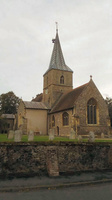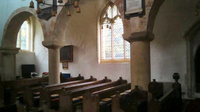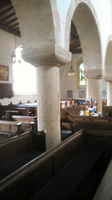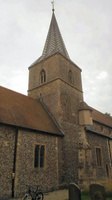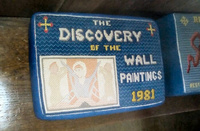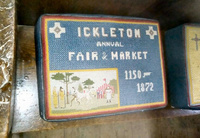Today's medieval church visit... (being the professional photographer that I am, I completely forgot to put an XQD card in my camera today - so these are all taken on my crappy phone)
St Mary Magdalene church was started sometime around the end of the 11th Century and the start of the 12th. We think of eight centuries as a long time but there have been people living around where the church stands, in the little village of Ickleton, for a great deal longer than that - a Neolithic axe head found in the village in the 1970s shows people were here more than 4500 years ago. Not far away is a Bronze Age burial mound and several artifacts from that era, including a torq, have been unearthed nearby. Only half a mile from the church are the remains of a Roman villa, and a Roman fort and Romano-British village lie nearby too - any one of those sites may have been the original home of the Roman column, that hold up the otherwise typically Norman arcade inside the church. They're easy to spot - each one is carved from a single massive piece of stone whereas the Norman copies are made up of carved sections. They would have already been about a thousand years old by the time they were reused in the building of the church.
Like most old churches, St Mary Magdalene has been much altered over the years and, during a period when the village grew, enlarged to accommodate them. Arches in the Early English Gothic style were added to the crossings in the 13th century, and the south transept may also have been added at that time (a north transept may have dated from that period too, but has since been demolished). Much change came in the 14th Century when the height of the tower was increased and the spire added, new stained glass windows were installed, the nave and clerestory were rebuilt and various Decorated Gothic elements were added, with this work probably complete by 1351 when the church was rededicated to its saint. More work was done the following century with a new chapel and vestry and the rebuilding of the chancel along with new windows and a rood screen being installed, all in Perpendicular Gothic style. The pews were added at that time too, and remain in the church to this day. Little change was made for the next two hundred years, but in the 18th Century the vestry, north chapel and transept were demolished - and with no space left in the graveyard, there would be no more burials. Late in the 19th Century the chancel was renovated - the pescina and sedilla (a sink used for washing ceremonial vessels and a seat used by the priest during mass) look to be the same age, but in fact the pescina is 15th Century and the sedilla, created to appear as though it had been there just as long, was added during this phase of alterations.
One night in 1979, the church caught fire and the roof of the south transept was completely destroyed (some charred timbers were reused and can still be seen in the roof immediately upon entering. The fire was extinguished before more serious damage could be done, but the ancient interior suffered a great deal from the smoke. Cleaning took more than two years, but something remarkable happened: high up above the Roman columns, patches of bright red, green and gold appeared as the sooty whitewash (whitewash was slapped over the walls of almost all English churches at the time of the Reformation in the 16th Century in an effort to make them look more pure and austere) was removed - revealing the existence of medieval wall-paintings that had been forgotten for centuries. As more whitewash was stripped away, more and more paintings appeared: depictions of the martyrdoms of Saints Peter, Lawrence and Andrew and four scenes of Christ's Passion from the 12th Century, and then a Doom painting of the Last Judgement dating back to the 14th Century.
The tower has eight bells including the sanctus bell hanging outside the steeple - an unusual feature for an English church, but one that can also be seen at Hinxton only a short walk away. Two of the bells were cast by the world-famous Whitechapel Bell Foundry: the fifth bell in 1729 and the tenor bell in 1752 - one year before the Foundry's most famous bell, the Liberty Bell that was cast to celebrate the 50th anniversary of William Penn's Charter of Privileges. The Whitechapel Bell Foundry went out of business last year, after 450 years.
Photos
1: The church. My phone's camera isn't good enough to take a decent shot from a distance, so I'm going to have to go back with an 18mm to get a good close-up with the entire building in the frame. The spire's square base and octagonal upper section means it's a broach spire.
2: Most churches have impressive doors; this one's in especially good.
3: Looking in from just inside the doorway - the medieval paintings can be seen on the wall above the arcade of columns.
4: Looking down towards the altar which, surprisingly for a really quite grand church, is very modest. The Roman columns can be seen either side.
5-6: Roman columns, carved from single pieces of stone.
7: The tower. There is much indication of bricked up windows and other features which can't be seen at such low resolution.
8: Cushion thing for kneeling on when saying prayers (I have no idea what these are called), commemorating the discovery of the medieval paintings.
9 Cushion thing commemorating the village fair, which was abolished under the Fairs Act of 1871. The Victorians had a great love of medieval style, but they weren't at all keen on the surviving medieval fairs which tended to go on for several days and feature much drunkeness, rowdiness and ungodly shenanigans and were really not very different to a modern illegal rave. Along with several others, Ickelton's fair was declared to be "unnecessary, the cause of grievous immorality, and very injurious to the inhabitants of the towns in which such fairs are held" and banned.
10: Dragon-type creature carving on a pew.


Enjoy being online again!
Welcome to the community of good people who base their values on evidence and appreciate civil discourse - the social network you will enjoy.Create your free account
4 comments
Feel free to reply to any comment by clicking the "Reply" button.The pictures are still amazing even for your phone. The architecture is amazing.
Does this church have a baptismal font?
Thanks for sharing, I loved visiting old churches and castles. And so thankful I didn't live back then!
Me, 2!
Enjoy being online again!
Welcome to the community of good people who base their values on evidence and appreciate civil discourse - the social network you will enjoy.Create your free account
Share this post
Categories
Agnostic does not evaluate or guarantee the accuracy of any content. Read full disclaimer.
